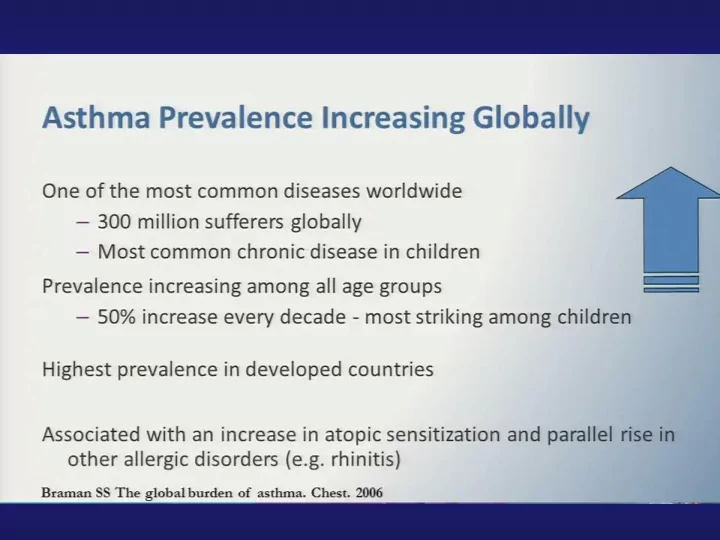

Asthma’s Impact in United States 26 million currently diagnosed (2010) 10.4 million outpatient visits 1.8 million ER visits 465,000 hospitalizations 3500 deaths Total cost $12.7 billion Source: CDC Center for Health Statistics
Current Asthma Prevalence: United States, 2001-2010 26 10 24 Percent Total number of persons 9 Total number of persons in millions 22 8 20 7 18 Percent 16 6 14 5 12 4 10 8 3 6 2 4 1 2 0 0 2001 2002 2003 2004 2005 2006 2007 2008 2009 2010 Year One in 12 people (about 26 million, or 8% of the U.S. population) had asthma in 2010, compared with 1 in 14 (about 20 million, or 7%) in 2001.
Distribution of Asthma by Race US v. NYC 1 million 10.4 million 100% 80% Asian Hispanic 60% Other 40% White Black 20% 0% US NYC Hispanics and Asians represent 42% of NYC asthmatics v 7% for US
Population Disparities in Asthma • Current asthma prevalence is higher among – children than adults – boys than girls – women than men • Asthma morbidity and mortality is higher among – African Americans than Caucasians Source: MMWR 2007;56(No. SS-8):1-54
Epidemiology Of Asthma • 50% of asthmatics present after age 15 • 50%-75% who present in childhood become asymptomatic by adulthood • 3% fatality rate (80% are over 30 years of age)
1995 Definition of NHLBI • Asthma is a chronic inflammatory disorder of the airways in which many cells play a role especially mast cells, eosinophils and T lymphocytes. In susceptible individuals, this inflammation causes symptoms which are associated with widespread but variable airflow obstruction that is often reversible either spontaneously or with treatment and causes an increase in airway hyperresponsivenes s to a variety of stimuli
Risk Factors for Developing Asthma • Strong factors – family history of atopy (3x) – house dust mites,cat dander,cockroaches,alternaria • Weak factors – male,low birth weight,prematurity, parental smokers, high salt diet • The role of infection on Th1 v Th2 cells
Mechanisms of Airway Obstruction • Bronchial smooth muscle contraction • Airway inflammation and mucosal edema • Increased and abnormally viscous mucus
Initial Assessment and Diagnosis of Asthma Determine that: – Patient has history or presence of episodic symptoms of airflow obstruction – Airflow obstruction is at least partially reversible – Alternative diagnoses are excluded
Clinical Features Asthma COPD Heart Disease – wheeze 90 78 28 – tightness 90 75 45 – SOB 90 75 45 – Cough VariantAsthma approximately 30 to 50% of patients with chronic cough have asthma, especially children
Mild and Severe Obstruction FEV 1 /FVC<LLN FEV 1 /FVC<LLN FEV1=35%-50% FEV1> 70% predicted predicted
Goals of Asthma Therapy Prevent chronic and troublesome symptoms Maintain (near- ) “normal” pulmonary function Maintain normal activity levels (including exercise and other physical activity)
Control of Factors Contributing to Asthma Severity Assess exposure and sensitivity to: Inhalant allergens (dust mites, cockroaches) Occupational exposures ( detect patterns) Irritants: Indoor air (including tobacco smoke) Air pollution
Control of Factors Contributing to Asthma Severity (continued) Assess contribution of other factors: – Rhinitis/sinusitis – Gastroesophageal reflux – Drugs (NSAIDs, beta-blockers) – Viral respiratory infections – Sulfite sensitivity
Overview of Asthma Medications (continued) As-needed: Quick Relief – Short-acting beta 2 -agonists (albuterol eg Proventil) – Anticholinergics(atrovent) – Systemic corticosteroids(prednisone)
Overview of Asthma Medications Daily: Long-Term Control – Corticosteroids (inhaled and systemic, Flovent ) – Long-acting beta 2 -agonists(salmeterol) – Long acting anticholinergics( Spiriva ) – Leukotrienemodifiers(montelukast, singulaire ) – IgE antibodies (omalizumab, Xolair ) – IL-5 antibodies (mepolizumab, nucala )
<
Recommend
More recommend